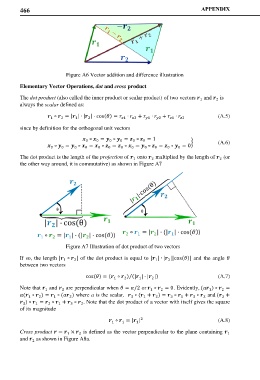Page 486 - Maxwell House
P. 486
466 APPENDIX
Figure A6 Vector addition and difference illustration
Elementary Vector Operations, dot and cross product
The dot product (also called the inner product or scalar product) of two vectors and is
1
2
always the scalar defined as:
∘ = | | ∙ | | ⋅ cos() = ∙ + 1 ∙ 2 + ∙ 2 (A.5)
1
2
2
1
2
1
1
since by definition for the orthogonal unit vectors
∘ = ∘ = ∘ = 1
0
0
0
0
0
0
� (A.6)
∘ = ∘ = ∘ = ∘ = ∘ = ∘ = 0
0
0
0
0
0
0
0
0
0
0
0
0
The dot product is the length of the projection of onto multiplied by the length of (or
1
2
2
the other way around, it is commutative) as shown in Figure A7
Figure A7 Illustration of dot product of two vectors
If so, the length | ∘ | of the dot product is equal to | | ∙ | ||cos()| and the angle
2
2
1
1
between two vectors
cos() = ( ∘ ) (| | ∙ | |)⁄ 1 2 (A.7)
2
1
Note that and are perpendicular when = /2 or ∘ = 0. Evidently, ( ) ∘ =
1
2
2
1
1
2
( ∘ ) = ∘ ( ) where a is the scalar, ∘ ( + ) = ∘ + ∘ and ( +
2
1
2
2
2
2
1
3
3
1
3
1
) ∘ = ∘ + ∘ . Note that the dot product of a vector with itself gives the square
1
2
3
1
3
2
of its magnitude
∘ = | | (A.8)
2
1
1
1
Cross product = × is defined as the vector perpendicular to the plane containing
1
1
2
and as shown in Figure A8a.
2

